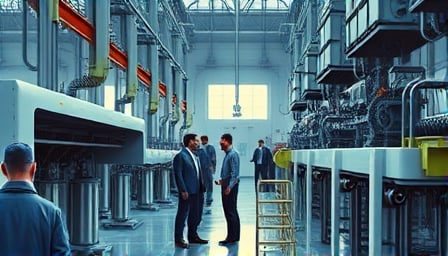CRUN: Riding the AI Wave Amidst Industrial Challenges
In a remarkable surge, CRUN, a key player in the machinery sector listed on the Shenzhen Stock Exchange, has been riding the wave of the AI-driven industrial boom. As of August 19, 2025, the company’s stock closed at 16.38 CNY, a significant climb from its 52-week low of 4.34 CNY on August 22, 2024. This surge is part of a broader trend where A-share robot concept stocks have seen an overall increase of 1.96%, with many hitting their daily price limits.
The AI Revolution: A Double-Edged Sword
The industrial sector, particularly machinery, is at the forefront of the AI revolution. Analysts from Wanlian Securities have highlighted 2025 as the “year of mass production for humanoid robots,” with China poised to lead the global industry. This optimism is fueled by China’s supply chain efficiencies and innovative applications. However, the road ahead is fraught with challenges. The AI industry grapples with issues such as insufficient AI generalization capabilities, high costs of training in real-world environments, and a significant gap between consumer price expectations and current production costs.
CRUN’s Position in the AI Machinery Landscape
CRUN, among other companies like 川润股份 (Chuānrùn Gǔfèn), has been a significant beneficiary of this industrial upswing. The company’s stock performance reflects the broader market’s enthusiasm for AI and robotics. However, the industry’s core challenges—ranging from technological maturity to cost reduction—pose potential hurdles for sustained growth.
The Infrastructure Boom: A Catalyst for Growth
The AI industry’s infrastructure needs are set to explode, with OpenAI’s CEO, Sam Altman, announcing plans to invest trillions of dollars in AI infrastructure. This massive investment is expected to catalyze a new wave of growth in data center construction, financial operations, and policy support. For CRUN and its peers, this presents both an opportunity and a challenge. The demand for advanced cooling systems and power distribution, critical components of AI infrastructure, could drive significant growth. Yet, the ability to capitalize on this opportunity will depend on navigating the technological and financial complexities of the AI revolution.
Looking Ahead: Challenges and Opportunities
As CRUN and the broader machinery industry navigate the AI revolution, several factors will determine their success. The ability to overcome technological hurdles, reduce production costs, and meet consumer expectations will be crucial. Moreover, the impending infrastructure boom presents a significant opportunity for growth, provided companies can adapt to the rapidly evolving landscape.
In conclusion, CRUN’s journey through the AI-driven industrial boom is emblematic of the broader challenges and opportunities facing the machinery sector. As the industry stands on the cusp of a new era, the path forward will require innovation, resilience, and strategic foresight.
